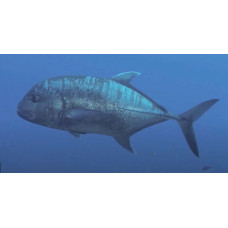Latin name
Caranx lugubris
Other names
Black trevally, black kingfish, coal fis, black ulua.
Identification
They have a body shape similar to other Caranx species - elongated, compressed, with the dorsal profile more convex than the abdominal profile. The convexity is most pronounced on the head, which slopes steeply downward, giving the head profile a very angular appearance. The line between the snout and the back of the head is concave, with a depression in the middle near the nostrils. The mouth is quite large compared to other members of its genus, and the upper jaw extends below the center of the fish's eye. The upper jaw contains a row of strong external fangs with an inner band of smaller teeth, while the lower jaw contains a single row of widely spaced conical teeth The lateral line has a pronounced and moderately long anterior arch, the curved section of which crosses a straight section below the blade of the second dorsal fin. The curved portion of the lateral line contains about 50 scales, while the straight portion contains 26 to 32 stout flaps. The caudal peduncle also has paired keels on both sides. The thorax is completely covered with scales, which, like the rest of the body, are small and cycloid in shape. This species has a total of 23 to 30 gill rakers and 24 vertebrae.
Features of fish fins
The dorsal fin has two parts; the first has 8 spines and the second has 1 spine and 20 to 22 soft rays. The anal fin has 2 anterior spines and 16 to 19 soft rays. The blades of both the dorsal and anal fins are elongated. The pelvic fins contain 1 spine and 21 soft rays, while the pectoral fins are curved and longer than the head.
Fish colouring
The body is uniformly olive, brown, gray, and even black along the back, becoming gray-blue toward the lower body. The fins are gray to black and the flippers are black. A small dark spot, usually smaller than the pupil, is often present at the upper edge of the pupil.
Distribution
Circumpolar. Western Indian Ocean: off Natal and East London in South Africa; Reunion, Mauritius and Cargados Carajos; Seychelles. Western Pacific: from southern Japan to New Caledonia. Recently reported from Tonga. Western Atlantic: Bermuda and northern Gulf of Mexico to Brazil. Eastern Atlantic: Azores, Madeira, St. Paul's Rocks, Ascension Island, Cape Verde and Gulf of Guinea. East Central Pacific: Mexico (including the Revillagigedo Islands) to Costa Rica.
Habitat
A marine, oceanodromous, subtropical, benthopelagic species rarely found in shallow coastal waters, preferring deep, clear coastal waters from 12 to 354 meters deep. This species is most common in insular oceanic habitats and around coastal islands, rarely found near continents. It inhabits deep reefs and reef walls and is also common around oceanic seamounts. Has been recorded in the lagoons of the Solomon Islands.
Size
A large fish, it can reach a length of 1 m and a weight of 17.9 kg, although it is more common at less than 70 cm.
Behavior
Lives both alone and in aggregations of up to 30 individuals. Able to coordinate these aggregations on coral reefs based on the release of dimethylsulfoniopropionate (DMSP) from the reef. DMSP is a naturally occurring chemical produced by algae and, to a lesser extent, by corals and their symbiotic zooxanthellae. This species has also been recorded in the Atlantic Ocean in association with Seriola rivoliana and the larger Seriola dumerili.
Food and feeding habits
Its diet consists mainly of fish and crustaceans, including Stomatellinae and Isopoda, as well as molluscs. It has been speculated that this species may compete for food with Lutjanus campechanus in Brazil, as their diets are almost identical. It is also known to follow spinner dolphins to feed on their feces.
Reproduction
Males are almost twice as common as females. Sexual maturity is reached at 34.6 cm for females and 38.2 cm for males. The timing of spawning is poorly known, but it occurs in February, April, May, and from July to September. The reproductive behavior and early life history of this species are completely unknown.
Fishing
Important to commercial fisheries throughout its range, often the most common large species in catches on offshore islands. Caught in a variety of nets and traps as well as hook and line.
Relationship with a person
It is considered the best food fish available. There have been cases of ciguatera poisoning.
| Classification | |
| Phylum | Chordata |
| Class | Actinopterygii |
| Squad | Carangiformes |
| Family | Carangidae |
| Genus | Caranx |
| Species | C. lugubris |
| Features | |
| Conservation status | Least Concern |
| Habitat | Pelagic |
| Life span, years | No information |
| Maximum body weight, kg | 17,9 |
| Maximum length, cm | 100 |
| Sailing speed, m/s | No information |
| Threat to people | Edible |
| Way of eating | Predator |
Black jack
Tags: black jack



